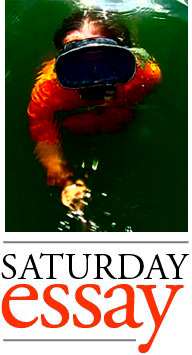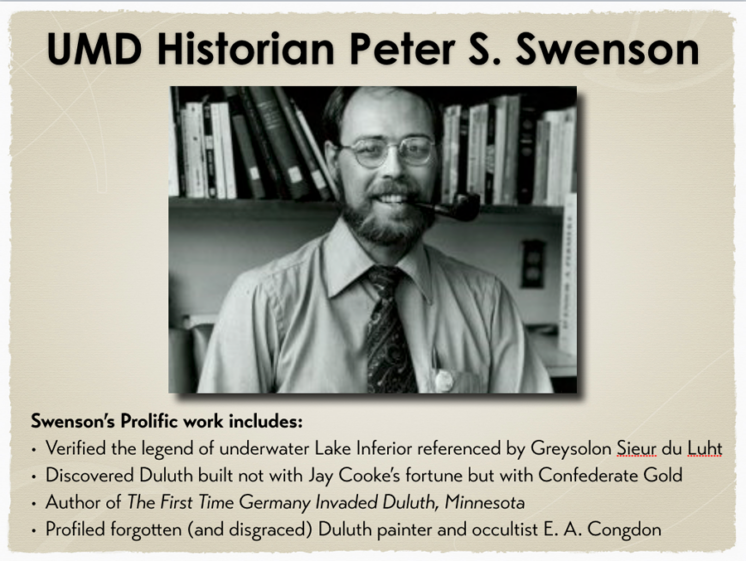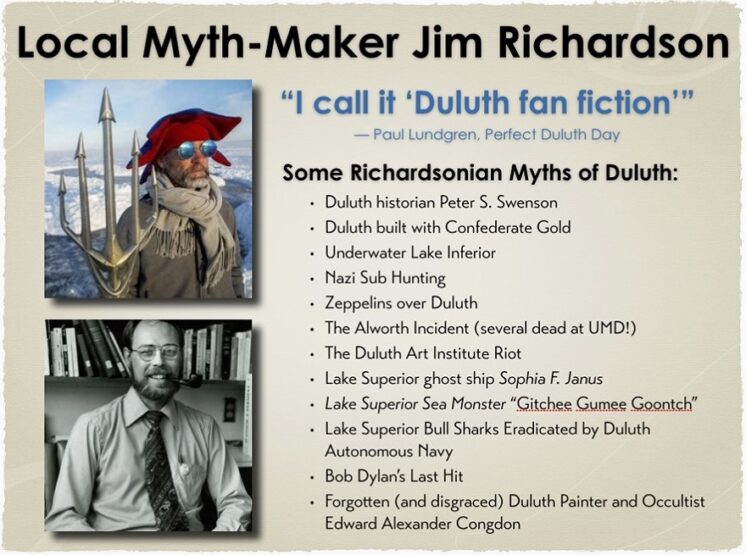Tony Dierckins on Jim Richardson: “Myth-Maker”
 About today’s essay, I told editor Paul Lundgren, “I love the April 1 publication date. This essay pulls back the curtain on my hoaxy stories, yet immediately discredits itself with the date. Beautiful!”
About today’s essay, I told editor Paul Lundgren, “I love the April 1 publication date. This essay pulls back the curtain on my hoaxy stories, yet immediately discredits itself with the date. Beautiful!”
On March 31, in conjunction with the Twin Ports Festival of History, Duluth historian Tony Dierckins gave the presentation “Duluth’s Greatest Myths.” I am pleased and proud he included my Perfect Duluth Day writing in a brief mention. He was kind enough to share the slides, below. They list some of my efforts and I have annotated them.
As I told Tony, I draw a distinction between my fiction and my myth-making “essays.” Both are set in Duluth. But for instance “The Alworth Incident” presents as non-fiction, but quickly reveals itself to be a screwball superhero origin story. Maybe it could become a rumor, but it is not designed to be believed per se. However my “myth-making” material, such as Lake Inferior: The Underground Lake Beneath Lake Superior, is specifically designed to live on as urban legend. These myths have “tells” but readers may miss them. Also, I have tailored the stories so Duluthians want them to be true. Lundgren called them “Duluth fan fiction,” naming the new genre. Allowing me to publish them as “essays” aided the crime. They were also tagged as “Hoaxes – Fake News – Satire – Folklore.”
Tony gets it. As a Duluth historian, he understands: I’m his competition. Just plausible enough to propagate on their own, my Duluth fan fiction is cluttering up his histories. As I’ve demonstrated before, since news-aggregator-bots uncritically hoover up blog posts and repackage them as news, outrageous fictions become reporting. The natural selection of the internet does the rest: I’m now seeing my mythical content in Chatbot-written articles presented as fact. Bad apples exploit this. But my stated goals are to entertain, to mythologize Duluth as the greatest city in the world (which it is), and to highlight the nature of disinformation.
Tony focused on my character Peter S. Svenson, Minnesota’s rogue historian, who I invented to provide unverifiable citations in several myths. The picture of the pipe-smoking professor I stole from the internet; it was the image in my mind and kind of like my dad. Tony included Svenson in a portion of his lecture called “Famous Duluthians Who Never Existed.” Svenson appeared after Howard Gnesen, Jean Duluth, and Grandma Rosa Brochi.
The follow-up slide is below:
My notes are below:
The top left picture is me; it ran in the Duluth News-Tribune during its coverage of the People’s Free Skate 2019, widely regarded as the best thing that ever happened.
“Duluth Historian Peter S. Svenson”: As above, Peter Sven Svenson is my sock-puppet whose fictional articles and books I quote to ground my myths in real-sounding malarkey. I proved his existence by announcing his death. ChatGPT got involved and invented a couple other fictional works of his, mentioned here. With AI chatbots known to make stuff up, it begs the question: Why is a society flooded with misinformation now choosing known liars as search engines? I began my myth series before this odious development. My stories should be included in media literacy courses: prove them wrong for an easy A.
“Duluth Built with Confederate Gold”: My roots are deeply southern but I got here as quick as I could. It fills me with unholy glee to think of good ol’ boys from below the Mason-Dixon line “doing their own research” on the mythical lost Confederate gold. The internet turns up many theories; thanks to me Duluth is well-represented amid the conspiratorial churn with this account and some supporting evidence. My point is to belittle backward claims about the Civil War, slavery, and race in America. I was disgusted by the murder of George Floyd in Minneapolis so many years after Minnesota saved the Union in the Civil War. This state fought against the south’s barbaric way of life that my family financially benefited from for generations. Duluth of course bears the stain of the lynchings, and the city’s treatment of its Native American citizens. I thought, what is required of the white citizenry is to proudly re-remember that Minnesota kicked the worst racists in the country in the ass at considerable cost of life, and to be proud of that fact, and to have it inform our modern views more fully. I had a vain and naïve notion that this could salve the spirit in the fight against racism in Minnesota, or spark discussion or hope or something. To bolster the already insanely heroic reality of the Minnesota 1st, I created a heroic myth of a non-racist white Minnesotan who proudly fought the South and desecrated its racist ideals by robbing them blind, and who pointedly denounced the Indian Wars in the same story. Along the way I kick Jay Cooke in the shins for driving his railroad rather impolitely through Sitting Bull’s back yard. Race in America was in a terrible place, but at least the good guys won the Civil War. Virginia will get its battle flag back over my dead body. I say that proudly as a refugee from the south.
“Underground Lake Inferior”: This story got around, with a lot of people incredulously sharing it without even reading it, which is the ax I’m grinding. The tale has a couple excesses (for instance the length of von Bitter’s airhose could not be tripled as depicted, because air pressure would drop and he would suffocate — which is arguably what happened anyway). But coming off a long jag of investigating the horrors of cave disasters, I thought, “What if I put all the horrors into one story?” I had the idea of Lake Inferior some years ago, in my comic strip “The Guys Who Never Stop Fighting” in the Transistor (characters co-created with Allen Richardson). Many people shared this impossible story on social media wondering if its easily-checked details were true. May the idea of a scary-lake-beneath-the-lake continue long after we are forgotten. It is not the myth Duluth wants, but it is the myth Duluth deserves.
“Nazi Sub Hunting”: The story is all suggested, and the reader can’t be sure if “Duluth’s Granny” is crazy, or if the subs are real, or both. I prefer the ambiguity. Initially my plan was to end it with an action sequence. A German U-boat was going to surface beneath Granny, which she would destroy with hand grenades and by commandeering its anti-aircraft gun and turning it on the tower. I worried that the word “granny” was a Southernism (I called my North Carolina grandmother Granny). Up here it’s more “Grandma” or “Gramma.” But I went with Granny. In retrospect I should have gone with Grandma to confuse her identity with the Grandma of Duluth restaurant fame. This story remained incomplete for some time until I learned of the rescue buoys of the North Sea in World War II. They were never used in the Great Lakes, but idle downed pilots seemed perfect counterpoints to a sub-hunting granny. I wrote until the story seemed finished, and I never even got to the big action sequence.
“Zeppelins Over Duluth”: A World War I story. Similar to how I conceived the Lake Inferior tale, I had just read a book about blimp and zeppelin disasters (Airshipwreck by Arnold Schwartzman and Len Deighton). I thought, “How many of these details can I cram into a single story?” I leavened it with research on biplane combat, including the factual reference to a grappling hook deployed mid-air in the early days of dogfights.
“The Alworth Incident (several casualties at UMD!)”: This is less of a myth-maker and more science fiction, a superhero origin story located in UMD’s physics building. This was co-written with Allen Richardson, featuring characters developed in “The Guys Who Never Stop Fighting.” It originally appeared in the Transistor in excerpt form.
“The Duluth Art Institute Riot”: Co-written with Allen, this imagines a Duluth where art becomes so important it is worth dying over, and the city remakes itself into a living performance, the greatest single artwork of all time. A variant of this tale ran excerpted in the Transistor. The inspiration is from the book Lipstick Traces and its history of the avant-garde movements of the 20th Century.
“Lake Superior Ghost Ship Sophia F. Janus”: This story is an homage to J.G. Ballard’s idea that turning inward offers the same infinites and dangers as the real world. I wrote it at the peak of COVID lockdown. Like the house in the Ballard story “The Enormous Space,” my ghost ship is a metaphor for the human skull and its labyrinths. The “F” in “Sophia F. Janus” I chose in a cheeky mood to imply the F-word, next to “Janus” which contains the word “anus.” This juvenilia was counterbalanced by the word “Sophia” implying wisdom. The story was written after research into abandoned “ghost” ships.
“Lake Superior Sea Monster ‘Gitchee Gumee Goontch’”: Lake Superior is worthy of a sea monster. Although a giant catfish is unrealistic as it would be too cold, real-life giant-ish catfish are a thing in the media, with the “River Monsters” show and the like. There are legends, maybe even true, of very large catfish drowning and eating people; in India these quasi-legendary fish are called the “goontch.” The alliteration with “Gitchee Gumee” was irresistible. I incorporated my old fantasy of swimming across the mouth of the canal, which I contemplated doing once upon a time until I learned it could kill me. I worked in a reference to Presque Isle, Michigan because of spurious hoaxy accounts of a “Presque Isle Monster”; that is why I set the story’s initial encounter there. I also threw in the lake’s toxic barrel dump. What better explanation for the giant size of the creature than mutagens leaking from the barrels? The idea of a paralyzing toxin in catfish spines is real. This myth was a way of working out my terror of being eaten whole by a giant predator, which is why I don’t swim in the ocean.
“Lake Superior Bull Shark Eradicated by Duluth Autonomous Navy”: This is a long story detailed here. Short version: I ridiculously claimed on PDD that this happened and the internet picked it up. What can you do?
“Bob Dylan’s Last Hit”: I’m particularly proud of this short story, which takes as its starting point Minnesota’s connection to the mafia of yore. I combined this with the ice-cold Dylan of “Positively 4th Street” — which the beloved Duluth bakery named itself after, even though the song is the most brutal diss track ever recorded. Anyone that cold could be an assassin, and after researching snipers, I had a vision: Duluth’s most famous son as a mafia hitman shooting from the clock tower, providing the reason he (almost) never returned to the city of his birth. If you Google “Bob Dylan’s last hit,” this is the second result after his JFK assassination song “Murder Most Foul.” Nothing weird about that. I have in mind a prospective sequel. I imagine Dylan’s 1966 near-fatal motorcycle accident in New York as a mob hit retaliating for the hit he made in Duluth. Then Dylan and the Band wipe out the gangsters in the Kitchi Gammi Club and release an album the same year.
“Forgotten and Disgraced painter Edward Alexander Congdon”: Part of coming up with such semi-plausible fake ideas includes building them on similar ideas that already exist. In this case, the sad and tragic murder at Glensheen Mansion in the 1970s lies in the imagination of every Duluthian. I thought, “Well it’s macabre and borderline disrespectful to the dead, but Duluthians will be primed to believe even darker things about the mansion that have only to be suggested, even if by a disreputable local fabulist.” Edward Alexander Congdon is based on Aleistar Crowley, whose real name was Edward Alexander. This is a wink in the story to actual magicians, who took notice and commented on it. I could only hope the Glensheen staff would take it in good humor. I later heard an applicant for the position of managing director cited my story as fact in a job interview, and was informed then and there that it was fake. I had provided a service to the estate, helping Glensheen weed out candidates with an insufficient sense of historical authenticity and sources. You’re welcome! The fact that Tony gave his lecture at Glensheen fills me with joy.
Also that he has coined the term “Richardsonian.” Now if I could only be sure Tony isn’t a figment of my imagination …
An index of Jim Richardson’s essays may be found here.
Recommended Links:
Leave a Comment
Only registered members can post a comment , Login / Register Here
















2 Comments
Dave Sorensen
about 2 years agoJim Richardson (aka Lake Superior Aquaman)
about 2 years agoGod bless Harry Senn. An image search ("1980s pipe-smoking professors") for the father figure of my UMD folklore story turned up a UM folklorist who reminded me of my deceased educator dad. Moved by the synchronicty I detourned his image in homage to both men